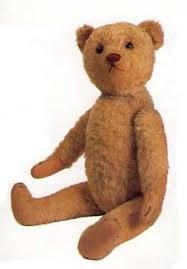 Beginnings
Beginnings
Gebruder Bing was founded in 1863 by brothers Ignaz and Adolph Bing in Nuremberg, Germany not as a teddy bear factory but as a tin manufacturing company. For a while the company made fine pewter and copper tableware and kitchen items. But in 1881 the brothers graduated to making metal toys, especially mechanized toy trains and live steam powered toys. They produced for the high end market and quickly established an excellent reputation. Their first toy factory was set up as the Bing Brothers’ Nuremberg Toy Factory in Karolinestrasse, changing the name to Nuremberg Metal and Enamelware Works in 1895. At that time Adolph left the company and Ignaz became chairman.
By the early 1900’s, Bing was the largest toy company in the world. They employed about 3,000 employees and had showrooms all around Europe including Berlin, London and Paris.
Then came the teddy bear craze. Bing joined in, making its first teddy bear in 1907, thus setting out to challenge Steiff.
There was a problem with those early Bing teddy bears, however – they looked a lot like Steiff teddy bears, with similar mohair coat styles and colors, similar heads with boot-button eyes, felt pads for paws and feet, humped backs, and arms longer than legs.
Early Bing Teddies
Those early Bing similarities to Steiff didn’t end with the teddy bears’ looks; they extended right down to a button in the ear, although the Bing button was in the right ear instead of the left as were Steiff’s. Steiff protested, and finally Bing put a metal tag under their bears’ left arms, later moving it to the bears’ right arms. By calling it a tag instead of a button, Bing managed to placate Steiff. Bing eventually replaced the button with a metal tag in 1920.
These early similarities make it difficult for collectors to tell Bing teddy bears from those made by Steiff.
Bing, however, did not limit itself to producing soft teddy bears. They were also known for making mechanical bears beginning in 1908 with a bear that could move its head. There were also bears on wheels that could be pulled, wind-up teddy bears, and even a somersaulting bear in 1911 (though production on this bear was eventually stopped in 1915 due to a lawsuit from Steiff who had a similar bear).
Bing teddy bears were, however, different from Steiff bears in subtle ways as the company sought to distance itself from Steiff beginning in the 1920’s. Bing teddies came to have mischievous faces with a big smile, long shaved muzzles with double stitched embroidered noses and orange glass eyes; they also had shorter arms and legs. And for a while, some of the earlier Bing bears had their ears and faces made out of a single piece of fabric.
The Effects of World War I
Bing suffered through World War I in much the same way as did other toy manufacturers as their factories were forced to produce military goods and what teddy bears they did make restricted for import by many countries. After the war it tried to rebuild under the leadership of Ignaz’s son Stephen who took over after his father died in 1918 with the introduction of a more cheerful teddy bear.
But Bing proved to be too big to be nimble. Their large factory and workforce meant a large overhead. The company struggled. Stephen Bing and his son left the company in 1932; also in 1932 factory production ceased and Bing went into receivership and its equipment was auctioned off. Stephen and his son fled to England soon after to escape Adolf Hitler’s campaign against Jews (the Bings were Jewish).
Yet even though Bing stopped producing bears quite some time ago, many Bing bears remain and are still favorites with collectors.
